A study in 2016 by Hosseini et al. looked into neurofeedback training for improving executive functions. They found it to be effective and a good way to boost cognitive skills1. This shows how neurofeedback can help with emotional intelligence and social cognition.
Brain training through neurofeedback is a new way to make our brains more flexible and improve thinking skills2. It gives feedback on brain activity in real time, helping people control and improve their brain’s performance2. This method is being used in many areas, like helping with ADHD, anxiety, depression, and learning issues2.
Knowing how to handle your own and others’ feelings is key to doing well in life and work. Loriette et al. in 2021 talked about how neurofeedback can help with this. They showed how it can make the brain more adaptable and improve thinking skills1.
Key Takeaways
- Neurofeedback training helps with thinking skills and executive functions.
- It makes the brain more adaptable and boosts thinking abilities by giving feedback on brain activity.
- Knowing how to manage your feelings is important for getting along with others and doing well in life.
- Neurofeedback can improve emotional smarts and how we understand others.
- New methods like task-based neurofeedback are promising for better thinking and emotional health.
Understanding Emotional Intelligence and Its Importance
Emotional intelligence is about knowing and handling your own feelings and those of others. It’s key for dealing with complex social situations, building strong relationships, and doing well in life and work.
Defining Emotional Intelligence
Emotional intelligence has five main parts: self-regulation, motivation, self-awareness, empathy, and social skills3. Knowing your own feelings and how they affect you is part of self-awareness. Managing those feelings is self-regulation3. Motivation keeps you going towards your goals with passion3. Empathy helps you understand and connect with others’ feelings, making social interactions better3.
The Role of Emotional Intelligence in Social Interactions
Emotional intelligence is crucial for getting along with others. It helps you talk well, solve problems, and build strong relationships. Growing up in a big family can help you learn these skills from your family3. But having distant parents or mental health issues can make it harder to develop emotional smarts3.
The Impact of Emotional Intelligence on Personal and Professional Success
Being emotionally smart can greatly improve your life and career. It leads to better mental health by helping you handle stress and communicate well3. At work, leaders with high emotional intelligence motivate their teams, creating a positive work environment.
| Emotional Intelligence Assessment Tools | Description |
|---|---|
| Mayer-Salovey-Caruso Emotional Intelligence Test (MSCEIT) | Has 141 questions to measure how well you understand and use emotions, with a top score of 2004. |
| Emotional Quotient Inventory (EQ-i 2.0) | 133 questions cover five emotional intelligence areas: self-perception, self-expression, interpersonal, decision-making, and stress management. Scores range from 0 to 100 for each area and up to 500 overall4. |
| Observation and Feedback | Others can also rate your emotional smarts through feedback, like in performance reviews or 360-degree feedback4. |
Improving emotional intelligence takes time, but you can do it with practices like journaling, mindfulness, and neurofeedback training4. By working on yourself and understanding your feelings better, you can boost your emotional smarts and grow personally3.
The Brain’s Role in Emotional Intelligence
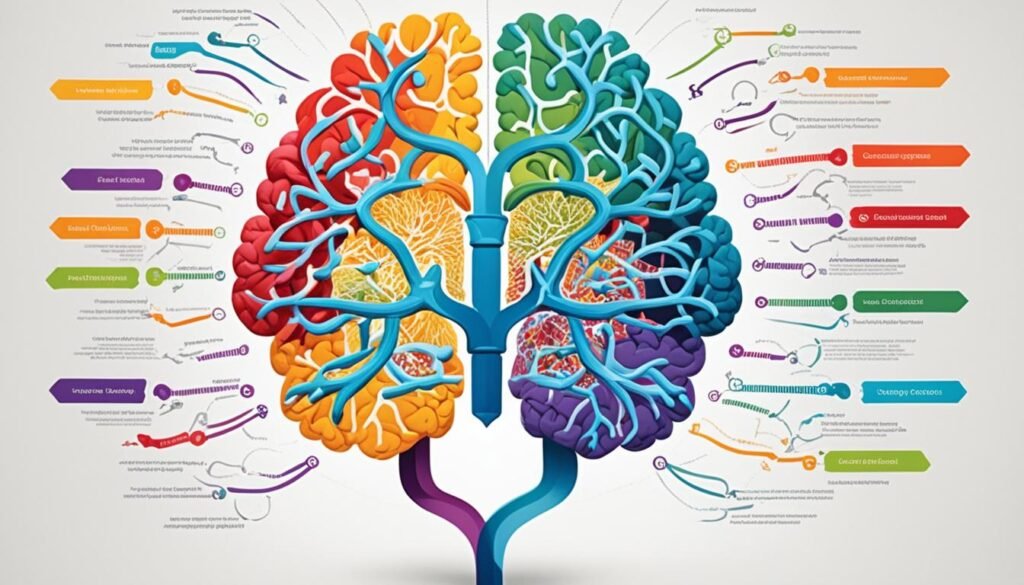
To understand emotional intelligence, we must look at how our brain works. It has many regions and circuits that help us feel and manage emotions. This shapes our emotional smarts. Neurofeedback is a new way to train the brain to handle emotions better by using real-time brain activity data5.
Key Brain Regions Involved in Emotional Processing
Some brain areas, like those in the limbic system, are key for handling emotions. The amygdala, a small almond-shaped part, is important for feeling fear and anxiety. It helps us remember stressful times6. The hippocampus is also part of the limbic system and helps with learning and emotions, and it makes new neurons6.
The prefrontal cortex in the frontal lobe is for thinking and controlling emotions. It helps the amygdala and other parts of the brain work better. The ventral tegmental area makes us feel happy by producing dopamine6.
Neural Networks Associated with Emotional Regulation
Handling emotions is a complex task for the brain. It involves many networks, like the emotion regulation network. This network has areas like the dorsolateral prefrontal cortex, ventrolateral prefrontal cortex, and anterior cingulate cortex. They work together to manage our feelings and use strategies to keep emotions in check.
The limbic system connects with the endocrine and autonomic nervous systems. It starts the fight-or-flight response and sends signals with neurotransmitters like serotonin and dopamine6. If this balance is off, mood disorders can happen, leading to slow thinking and indecisiveness6. Fixing the balance with neurochemicals helps us feel better and more resilient6.
Neuroimaging has given us new insights into emotional intelligence. By watching the brain during emotional tasks, scientists can see which areas and networks are active. This helps them create new ways to improve emotional smarts, like neurofeedback. The brain can change and learn, so we can train it for better emotional control and resilience5.
Introduction to Neurofeedback
Neurofeedback, also known as EEG Biofeedback, has become widely accepted over the last decade7. It’s used alongside other brain imaging tools like fMRI feedback. This method lets people control their brainwaves in real-time to improve their mental and emotional states. It’s now used more and more in both improving performance and in medical settings7.
What is Neurofeedback?
Neurofeedback uses Brain-Computer Interface technology to help people control their brainwaves. During a session, electrodes measure the brain’s electrical activity. This activity is then shown on a computer screen. The goal is to change brainwave patterns by focusing on specific tasks or mental strategies.
How Neurofeedback Works
Neurofeedback changes the brain’s electrical activity through a process called Neuromodulation. As people learn to control their brainwaves, they get feedback in real-time. This feedback helps the brain create new pathways and strengthen the desired brain activity patterns. This leads to better mental and emotional health.
Benefits of Neurofeedback for Cognitive and Emotional Functioning
Neurofeedback has many benefits for the brain. It’s especially useful for treating Attention Deficit Hyperactivity Disorder (ADHD)7. By training to control brainwaves, people with ADHD can improve focus, impulse control, and reduce hyperactivity.
It also helps with creativity and performance. For example, training in alpha and theta brainwaves can boost creativity in music and the arts7. Alpha brainwaves are key to creativity studies7. Neurofeedback has made a big difference in creativity for musicians, dancers, and actors7.
| Neurofeedback Training Bundle | Price | Discount |
|---|---|---|
| 2-Channel Essentials | $5,235.00 | $600.00 |
| 2-Channel Clinical Pathway | $5,895.00 | $600.00 |
| 4-Channel Clinical Pathway | $6,285.00 | $690.00 |
Some programs offer comprehensive neurofeedback training. These courses give 48 Continuing Education (CE) credits8. They include 36 hours of lectures and four live sessions for hands-on practice8. The cost ranges from $5,235.00 to $6,285.00, with discounts up to $690.008. These programs have helped many clinicians succeed with neurofeedback in their work8.
Neurofeedback Techniques for Enhancing Emotional Intelligence
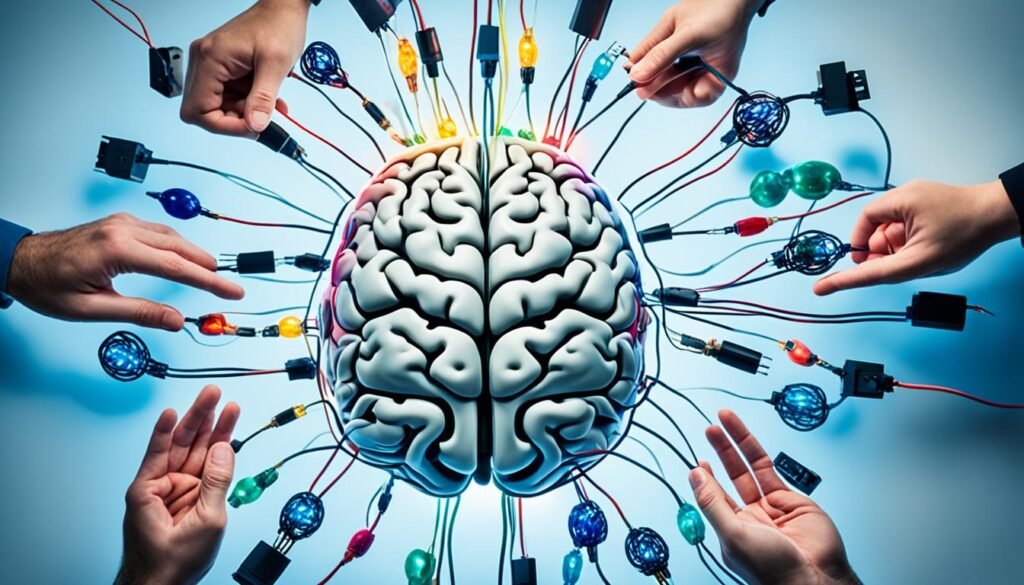
I’ve seen how neurofeedback changes lives by boosting emotional smarts. Emotional smarts are key to success, making up to 90% of it9. These techniques use tech to help people know themselves better, control their feelings, and stay motivated through games9.
Three main neurofeedback methods help improve emotional smarts: real-time fMRI, EEG, and fNIRS. Real-time fMRI lets people watch and control their brain’s emotional areas live. EEG focuses on brainwaves that help with feelings and understanding others. fNIRS uses light to check and give feedback on brain activity in emotional areas.
Studies show fNIRS neurofeedback is good for managing feelings. In one study, people learned to boost a key brain area with fNIRS signals10. This made them better at handling emotions and connected their brain networks better. But it didn’t change connections between some brain areas10.
Adding neurofeedback to other methods like thinking differently and meditation boosts emotional smarts even more9. These methods help reduce negative feelings and improve controlling emotions9. This mix helps people get better at handling their emotions and understanding others.
The five major categories of emotional intelligence skills include self-awareness, self-regulation, motivation, empathy, and social skills9.
Playing mind-controlled video games can make people more motivated and do better in life, work, and sports9. We can see how well brain-training works by looking at how people act and live their lives9. As neurofeedback gets better, I think we’ll see more big advances in teaching emotional smarts.
| Neurofeedback Technique | Target Brain Regions/Networks | Key Benefits |
|---|---|---|
| Real-Time fMRI Neurofeedback | Amygdala, Prefrontal Cortex | Improved emotional regulation and self-awareness |
| EEG Neurofeedback | Brainwave patterns associated with emotional intelligence | Enhanced emotional regulation and social cognition |
| fNIRS Neurofeedback | Right dorsolateral prefrontal cortex (rDLPFC), Emotion Regulation Network (ERN), Frontoparietal Network (FPN) | Increased emotion regulation and functional connectivity within ERN and FPN |
Real-Time Functional MRI Neurofeedback for Emotional Regulation
Real-time functional MRI neurofeedback (rt-fMRI-NF) is a powerful tool for learning how to control our brains. It helps people manage their emotions better11. By using this method, people can change their brain activity in certain areas related to emotions. This can help with mental health issues.
Principles of Real-Time fMRI Neurofeedback
rt-fMRI-NF works by measuring and giving feedback on the BOLD signal in real-time. This signal shows how active different brain areas are. By learning to control this activity, people can improve how they handle emotions11.
In these sessions, people try to change their feelings by changing their brain activity11. They get feedback on their brain activity during tasks, helping them learn better control over their emotions11. This helps them find ways to manage their feelings better.
Studies on Real-Time fMRI Neurofeedback for Emotional Regulation
Many studies have looked at how rt-fMRI-NF helps with emotional issues. People with mental health problems often struggle with managing their emotions11. For example, those with depression react differently to positive and negative things11.
Real-time fMRI was first used in 1995 by Cox RW, Jesmanowicz A, and Hyde JS12. Since then, it has improved a lot. By 2013, a review showed how far it had come and the challenges it faced12.
Studies on rt-fMRI-NF for emotions usually have several parts within an fMRI session11. They check if the brain activity changes as expected11. Control groups might get fake feedback or no feedback at all11.
| Study | Target Region | Outcome |
|---|---|---|
| Insula cortex self-regulation in schizophrenia (2011) | Insula cortex | Improved emotion recognition and brain connections12 |
| Mother-adolescent dyadic neurofeedback (n=6) | Right anterior insular cortex (aIC) | Less aIC activity over time13 |
These studies show how rt-fMRI-NF can help with emotional issues and understand the brain better. As research goes on, it could become a key tool in treating mental health problems. It could help people manage their emotions better.
EEG Neurofeedback for Improving Emotional Intelligence
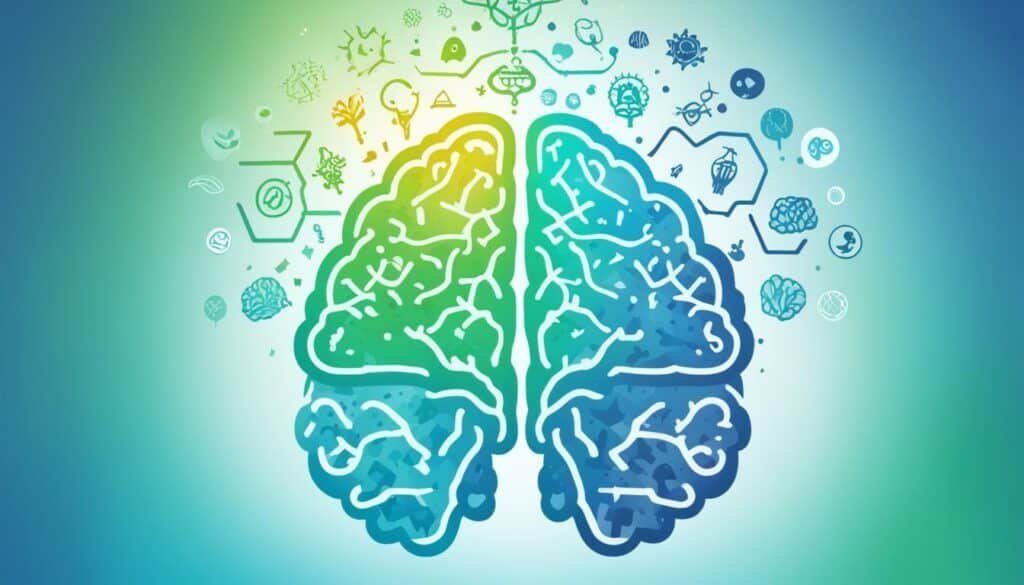
EEG neurofeedback is a new way to boost emotional smarts by teaching people to control brain waves linked to feelings and thoughts. It’s a safe, medicine-free method used for treating mental health issues like epilepsy, ADHD, and anxiety14. This therapy helps fix brain connections to lessen symptoms of brain problems15.
EEG Frequency Bands and Their Roles in Emotional Processing
EEG neurofeedback tracks brainwaves like alpha, beta, theta, and delta waves, each tied to different mental states16. Alpha waves mean you’re calm and relaxed, while theta waves boost creativity and deep calm16. These brainwaves are key to handling emotions well.
EEG Neurofeedback Protocols for Enhancing Emotional Intelligence
EEG neurofeedback focuses on alpha and theta waves to improve emotional smarts. People learn to boost these waves in certain brain areas. This has been shown to help with thinking and feeling better14. By controlling these waves, people can become more emotionally stable and flexible, and better at understanding others15.
EEG neurofeedback is getting more powerful, showing more benefits like better thinking, less stress, and better sleep16.
Neurofeedback does more than just help with feelings. It’s a way to boost brain power without drugs, making people smarter15. By tailoring therapy to each person’s brain needs, EEG neurofeedback could change how we learn to manage our emotions15.
fNIRS Neurofeedback for Emotional Intelligence Training
Functional near-infrared spectroscopy (fNIRS) is a new way to help improve emotional smarts. It uses a non-invasive method to check how the brain reacts to emotions. This helps people learn better emotional control and social skills.
A study with 62 healthy men showed how effective fNIRS can be. It found that people could boost brain activity in one session17. Even though it didn’t directly improve behavior, it did show better brain activity and connections during tasks17.
This study also found that people in the fNIRS group felt less depressed than those in the sham group17. To get accurate results, participants had to avoid certain substances before the test17.
“The study underscores the importance of investigating transfer effects for translating lab-based neurofeedback studies into real-life interventions.”17
Other studies have also shown good results with fNIRS neurofeedback:
- A study found that a remote neurofeedback system helped improve mental health18.
- Research has shown that neurofeedback can help with depression and anxiety18.
- Using fNIRS to recognize emotions has been very accurate18.
fNIRS neurofeedback is not just for emotional smarts. It’s also being used for other cognitive and emotional issues:
| Application | Findings |
|---|---|
| Attention Deficit Hyperactivity Disorder (ADHD) | It shows how ADHD brains work differently at rest and during tasks18 |
| Language Skills | It links resting brain activity with language skills in kids18 |
| Schizophrenia | It uses advanced tech to help with memory problems in schizophrenia18 |
fNIRS technology is getting better and could change how we handle emotions and social skills. It’s non-invasive, easy to use, and gives feedback in real-time. This could be a big step forward in improving emotional control and social understanding.
Combining Neurofeedback with Cognitive-Behavioral Techniques
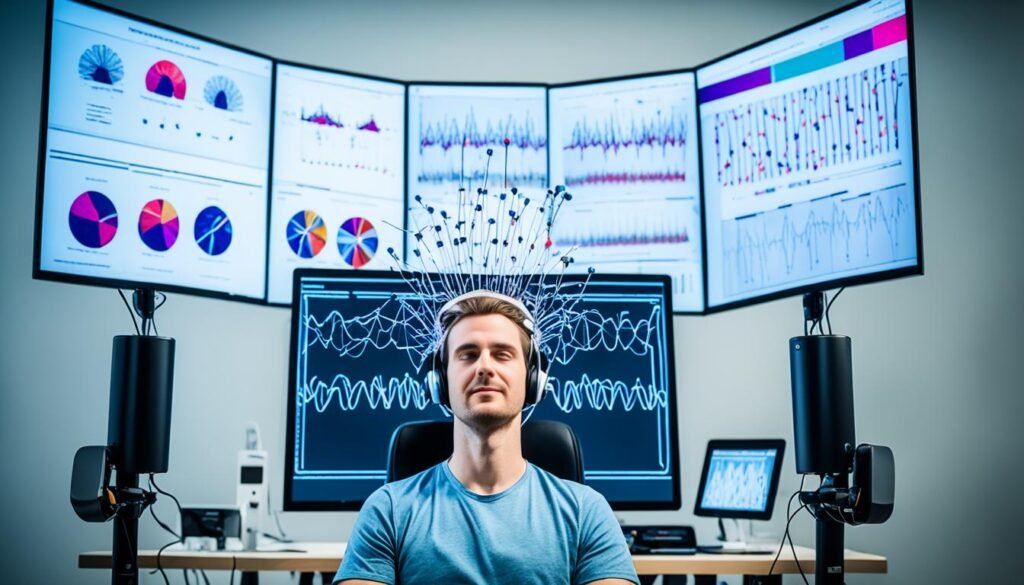
Using neurofeedback with cognitive-behavioral techniques helps improve emotional smarts and social skills. This mix of neurofeedback therapy and strategies like cognitive reappraisal and mindfulness meditation helps people manage their feelings better. It also boosts their emotional health.
In Saudi Arabia and the UAE, health experts are adding neurofeedback to cognitive-behavioral therapy (CBT). This new approach helps people with mental health issues like anxiety, depression, ADHD, and PTSD get better faster19.
Integrating Neurofeedback with Cognitive Reappraisal Strategies
Cognitive reappraisal is a way to change how we see emotional things in a positive way. When combined with neurofeedback, it helps people control their brain and emotions better. This mix makes both techniques work better, improving emotional smarts.
Studies show neurofeedback helps with ADHD symptoms, depression, PTSD, and anxiety20. It’s more effective than not treating these conditions at all20.
Neurofeedback-Assisted Mindfulness Training for Emotional Regulation
Mindfulness meditation focuses on the now without judgment. Adding neurofeedback to this practice shows people their brain activity in real time. This helps them understand and control their feelings better, making them smarter emotionally and socially.
Neurofeedback therapy often needs many sessions to really help with anxiety and depression20. But, using AI and Blockchain can make it even better by creating custom treatments in Saudi Arabia and the UAE19.
| Technique | Key Benefits |
|---|---|
| Cognitive Reappraisal + Neurofeedback | Enhances emotion regulation skills and promotes adaptive emotional responses |
| Mindfulness Meditation + Neurofeedback | Improves self-awareness, emotional control, and overall emotional intelligence |
The way we treat mental health is changing. Virtual reality and Generative AI are making neurofeedback and CBT more engaging and effective19. By mixing neurofeedback with cognitive-behavioral techniques, doctors can offer a complete approach to improving emotional smarts. This looks at both the brain and mind to help with emotional control.
Case Studies: Neurofeedback for Improving Social Cognition
Neurofeedback has shown promising results in enhancing social cognition and emotional intelligence. It helps people with autism spectrum disorder (ASD) and those who are typically developing. By training certain brain areas, it improves social communication, empathy, and how we connect with others.
Neurofeedback Intervention for Individuals with Autism Spectrum Disorder
Autism spectrum disorder (ASD) often starts before a child is three years old. It’s caused by both genes and environment21. People with ASD find it hard to communicate, interact socially, and repeat certain behaviors21.
They struggle with social skills, which affects their desire to talk and be with others21.
Neurofeedback (NF) has shown to reduce autism symptoms and boost focus, attention, and brain activity in kids with ASD21. Studies show NF improves cognitive and social skills in these children, making their behavior and brain activity better21. It helps with alertness, focus, and metabolism by changing brain waves, which can improve thinking and social skills21.
In one study, a 15-year-old boy named J had trouble with focus, memory, and managing his time22. This affected his schoolwork, social life, and playing baseball22. After 19 NF sessions over eight weeks, his brain’s balance improved, especially in the frontal areas22.
After 47 NF and cognitive training sessions, J’s brain map was clear of past issues, and his symptoms were gone22. He felt better in focus, had more energy, and his thinking improved22.
Neurofeedback Training for Enhancing Empathy and Social Skills
Neurofeedback training also helps improve empathy and social skills in those who are typically developing. A study with 40 people showed that alpha NF training made visual working memory better and more precise23. This training increased alpha waves and improved visual working memory23.
Improving memory and thinking through neurofeedback can help with social understanding and emotional smarts. It makes it easier to process and remember social cues and emotions. This leads to better social interactions and relationships.
| Population | Neurofeedback Intervention | Outcomes |
|---|---|---|
| Individuals with ASD | Training specific brain regions and networks involved in social processing | Reduced autism symptoms, improved concentration, attention, brain activities, and social behaviors |
| Typically developing individuals | Alpha neurofeedback training | Enhanced visual working memory capacity and precision, potentially contributing to better social cognition and emotional intelligence |
These studies and research show how neurofeedback can improve social thinking and emotional smarts. By focusing on certain brain areas and frequencies, it helps people with ASD and others. This leads to better social skills, empathy, and relationships, making life easier and more successful.
Limitations and Future Directions of Neurofeedback for Emotional Intelligence
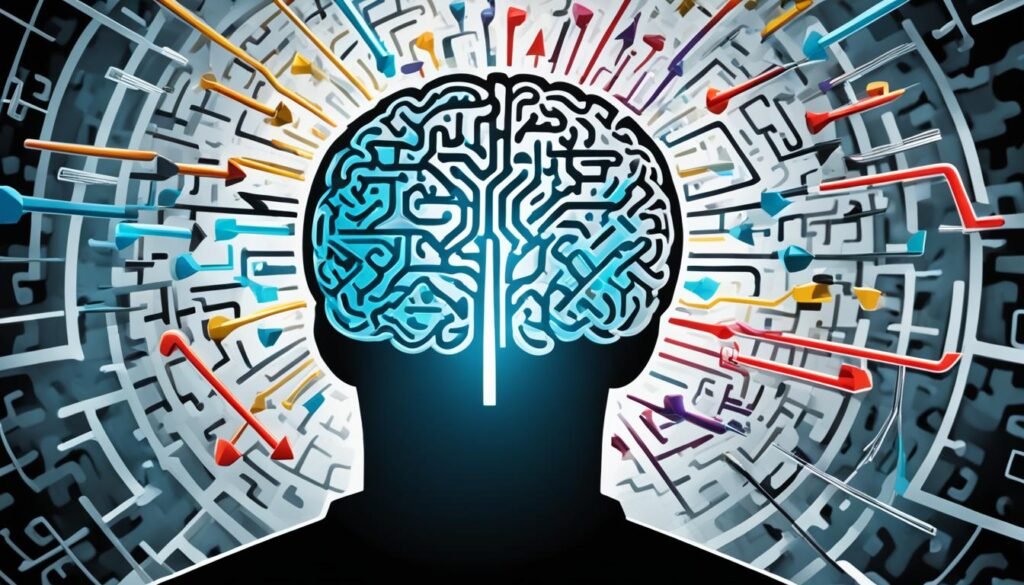
Neurofeedback has shown promising results in boosting emotional smarts. Yet, we must face the current challenges and limits in this field. A study looked at 3,626 articles and found key trends and topics in neurofeedback24. Despite its potential, neurofeedback faces methodological issues and research hurdles24.
Current Challenges in Neurofeedback Research and Application
One big issue is the lack of standard methods and small study sizes. This makes it hard to apply findings widely. Plus, brains differ, making it tough to create one approach that fits everyone.
Another challenge is the lack of long-term studies. We know short-term effects, but how long these changes last is unclear. This makes it hard to understand the lasting impact of neurofeedback.
Studies show neurofeedback can boost cognitive skills in healthy people25. But, it can also cause side effects like agitation and anxiety25. This highlights the need for careful use and tailored approaches.
Potential Future Advancements in Neurofeedback Techniques
The future of neurofeedback looks bright for improving emotional smarts. Researchers aim to create more tailored neurofeedback that fits each brain. New tech like real-time fMRI and high-density EEG will help make these interventions more precise.
We need bigger, controlled studies with clear methods and long-term checks. This will show if neurofeedback really makes a lasting difference. Mixing neurofeedback with other proven methods could lead to even better results.
“Neurofeedback’s potential to boost emotional smarts is huge. We need to tackle the current challenges to fully benefit from it. By improving our understanding and refining these techniques, we can create more effective, personalized help for the future.”
As we delve deeper into neurofeedback’s potential, addressing its current limits is key. This will help us develop stronger, evidence-based methods. These can improve emotional smarts and social skills in many areas of life.
Implementing Neurofeedback in Emotional Intelligence Training Programs
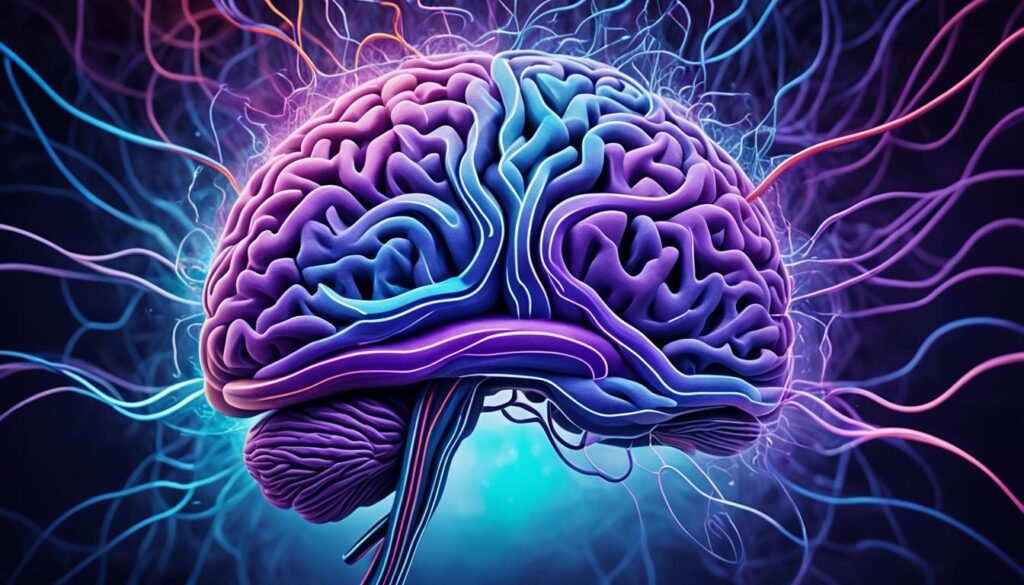
Adding neurofeedback to emotional intelligence training can make it much more effective. This method, also known as EEG biofeedback, lets people control their brainwaves in real-time26. It’s a key tool for improving employee well-being and success in companies.
To make the most of neurofeedback, training should match the needs and goals of the company and its workers. This means checking how well employees understand emotions, creating special neurofeedback plans, and offering support to keep up the good work.
“Neurofeedback has the potential to revolutionize emotional intelligence training in the workplace. By directly targeting the brain’s emotional regulation centers, we can help employees develop greater self-awareness, resilience, and social skills.”
How long neurofeedback training lasts depends on what each person needs and wants to achieve. Some might stop after reaching their goals, while others might keep getting coaching to keep improving26.
Working with experts like Neurohealth Associates ensures neurofeedback is used safely and effectively in training. They offer simple, non-invasive ways to boost mental health26. They’re open Monday to Friday, 8am to 8pm, and Saturdays, 8am to 3pm, making it easy for companies and their teams to fit into their schedule26.
Adding pros like Tamara Simon to the team can really boost the impact of neurofeedback in emotional intelligence training. With over twenty-five years of experience in making businesses better, Tamara Simon is a top expert27. She’s known for her leadership and management skills, often voted as one of the best at business events27.
- Assess individual and organizational emotional intelligence needs
- Develop customized neurofeedback protocols
- Integrate neurofeedback into existing training programs
- Provide ongoing support and evaluation
- Collaborate with experienced neurofeedback providers and trainers
By using neurofeedback in emotional intelligence training, companies can help their employees reach their full potential. This leads to better performance, stronger leadership, and more success overall.
Complementary Approaches to Neurofeedback for Emotional Intelligence
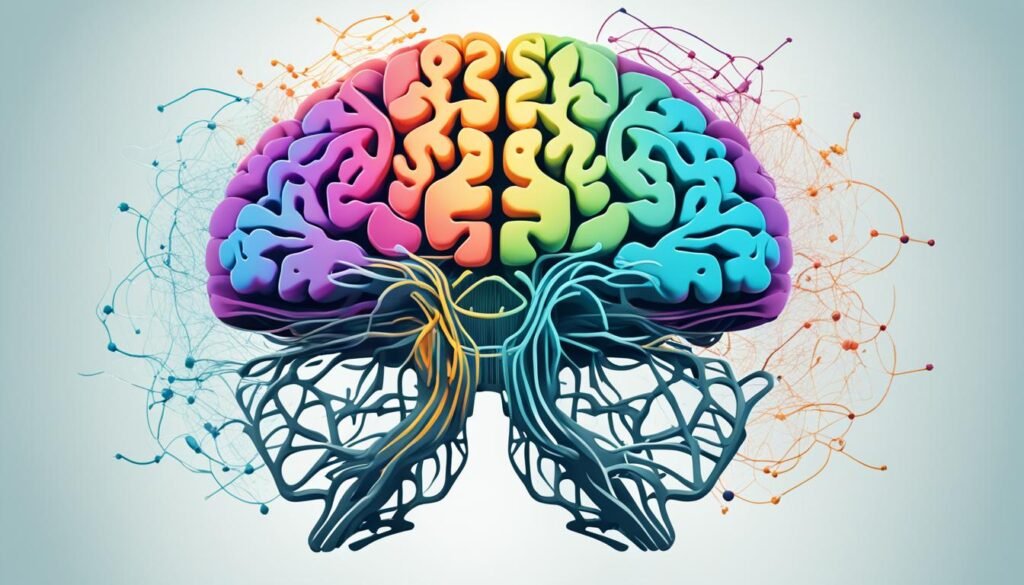
Neurofeedback is great for improving emotional intelligence, but it works even better with other methods. It helps improve brain function and manage emotions. Adding other techniques makes the training more complete and effective28. This way, people can learn many skills that help in social and work situations.
One good addition is emotional intelligence coaching and workshops. These offer personal guidance and hands-on learning. They help people understand their feelings better and improve skills like self-awareness and communication. Coaching focuses on building a strong relationship between the coach and the person being coached. This helps with personal growth and skill building.
Emotional Intelligence Coaching and Workshops
Coaching and workshops for emotional intelligence give a place for people to explore their feelings and learn how to handle them. They mix one-on-one coaching with group sessions. These sessions include activities like role-playing and group talks to boost self-awareness and empathy.
These sessions offer quick feedback and support. Coaches and leaders give advice and insights right away. This helps people work on their emotional intelligence better. Adding neurofeedback to this makes it even more effective by linking new brain skills to everyday life28.
Virtual Reality-Based Emotional Intelligence Training
Virtual reality training is another great way to improve emotional intelligence. It uses virtual worlds for safe practice. This lets people try out social situations and tough scenarios without real risks.
This method is great for building empathy and understanding others. By living through others’ experiences in virtual reality, people learn to see things from different angles. This can make them more aware of emotions and better at talking to others.
Using neurofeedback with virtual reality training is very powerful. It trains the brain to handle emotions better while practicing in virtual worlds. This full approach helps people develop both brain function and practical emotional skills.
Combining neurofeedback with coaching and virtual reality training is a strong way to boost emotional intelligence. It looks at emotional intelligence from many angles. This leads to a strong set of skills for personal and work life.
Research shows that using neurofeedback and other methods together is very promising. Mixing brain training with real-life experiences and personal coaching can unlock emotional intelligence. This can help people do well in today’s complex world. For more on neurofeedback and its uses, check out Positive Psychology.
The Future of Neurofeedback in Enhancing Emotional Intelligence
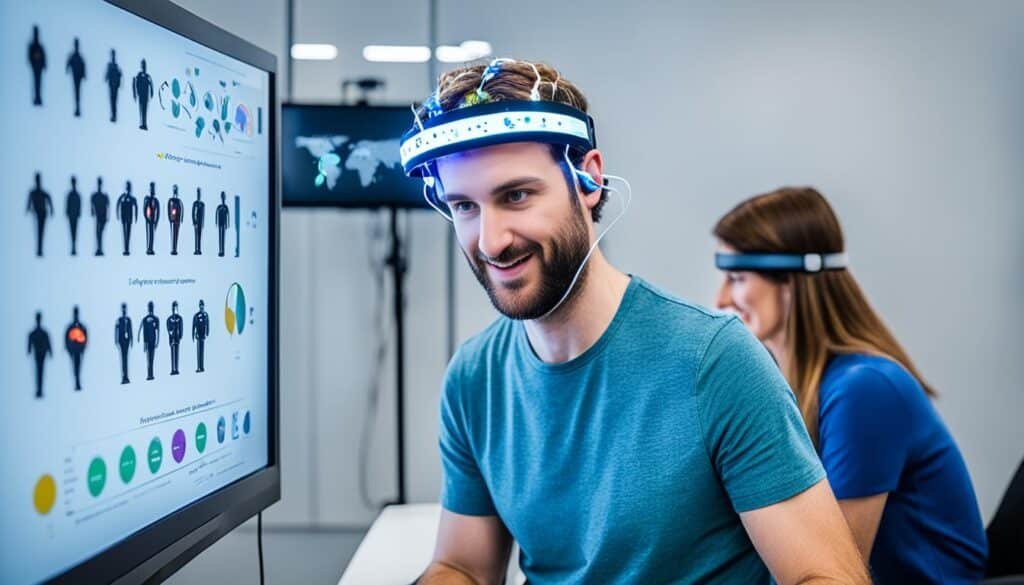
I’m excited about the future of neurofeedback and emotional intelligence. With new tech, we’ll get more precise and personalized neurofeedback. This means training can match our unique needs and goals, making it better and more effective29.
Wearable devices with neurofeedback are also a big deal. Imagine getting feedback on your feelings through easy-to-use gadgets. This could change how we handle emotions at work or school.
Neurofeedback looks promising for improving emotional smarts. It can boost memory, focus, and problem-solving skills by enhancing alpha waves29. It also helps reduce stress by teaching the brain to relax, making us more mindful and empathetic29.
As research grows, neurofeedback will likely become key for personal and work growth. For example, a study showed it helped music students be more creative29. Another study found it made art students more creative too29.
Neurofeedback could also change personalized medicine. By customizing neurofeedback, we might prevent and treat emotional issues better. A study found it eased anxiety and depression in people with chronic pain29.
In summary, the future of neurofeedback looks great for emotional smarts. With new tech, personalized care, and wearable gadgets, it could change how we manage emotions. I’m sure it will help us grow personally and professionally, and even prevent emotional problems.
Conclusion
Reflecting on neurofeedback’s potential, I feel hopeful. It can boost emotional intelligence and social skills. By training our brains, we gain better self-awareness, empathy, and control over emotions. Studies show it helps with depression, autism, and ADHD, among others30.
It’s also good for epilepsy, ADHD, and anxiety, and might help with brain injuries and more31. Neurofeedback helps balance brain waves, connect brain areas, and improve focus30.
Despite challenges, the benefits of neurofeedback are clear. As technology gets better and more people can use it, it could be key for personal growth and emotional health. Combining it with other methods could help us become more emotionally smart31.
While it’s not a cure-all for some issues, its potential for improving social skills is huge. Holistic approaches and other methods can help too.
Looking ahead, we should keep exploring neurofeedback’s potential. It takes about 25-40 sessions for lasting changes, and most people see benefits in the first ten30. Investing in brain training is a smart move.
By focusing on emotional intelligence and using neurofeedback, we can build a society that values empathy and clear communication. This leads to better personal and professional lives.
FAQ
What is neurofeedback and how does it work?
Neurofeedback, also known as EEG biofeedback, is a way to train the brain. It shows a person’s brain activity in real-time. This lets them learn to control their brainwaves with visual or sound feedback. By doing this, people can improve their thinking and feelings.
How can neurofeedback enhance emotional intelligence?
Neurofeedback helps by focusing on brain areas that deal with emotions. It works on the amygdala, prefrontal cortex, and networks for managing feelings. This helps people become more aware of their emotions and better control them. This leads to better social skills and relationships.
What are some neurofeedback techniques used for improving emotional intelligence?
There are different ways to use neurofeedback for emotional smarts. Techniques like real-time functional MRI, EEG, and fNIRS focus on brain areas for emotions. These methods help people control their brain activity. This leads to better emotional skills.
Can neurofeedback be combined with other approaches to enhance emotional intelligence?
Yes, neurofeedback can work with other methods like cognitive-behavioral therapy and mindfulness. This mix helps improve emotional smarts and social skills. It offers a full way to grow emotional abilities.
What are some potential applications of neurofeedback for emotional intelligence in real-world settings?
Neurofeedback can be used in many places like work, schools, and clinics. It helps train emotional smarts in programs. This can make people more aware of themselves, manage feelings better, and improve social skills. It can also help prevent and treat emotional issues.
What are some limitations and challenges in neurofeedback research and application?
Research on neurofeedback has some issues like small study sizes and not having standard methods. It’s hard to make interventions that work for everyone because brains are different. Future studies should aim to be bigger and more controlled to overcome these problems.
What advancements can we expect in the future of neurofeedback for enhancing emotional intelligence?
As technology gets better, we’ll see more precise and tailored neurofeedback. It might work with virtual reality and wearable tech. These advances could make neurofeedback more effective and easy to use. This could help improve emotional smarts and personal growth.
